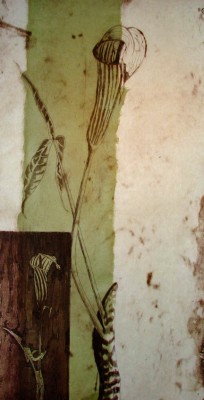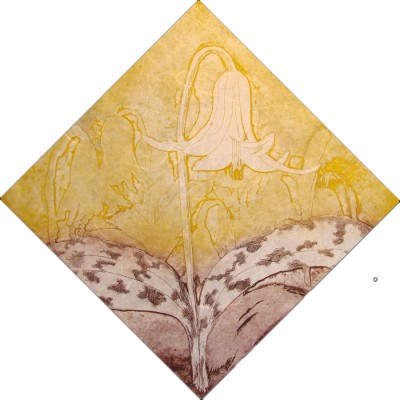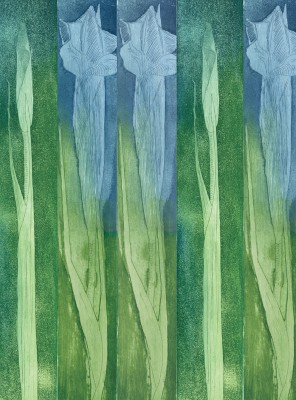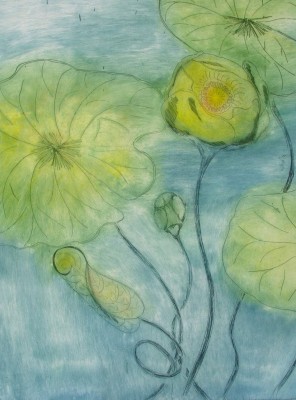Native Species
Ephemerals – lasting a day or a few days; short-lived, transitory
(The Concise Oxford Dictionary New Edition)
… we bid our readers heartily farewell, wishing them much pleasure and contentment, and that (this book’s ) contents, both artistically and literary, may serve to foster a love for the native plants of Canada, and turn their attention to the floral beauty that is destined sooner or later to be swept away, as the onward march of civilization clears away the primeval forest – reclaims the swamps and bogs, and turns the waste places into a fruitful field. The lover of flowers may then look in vain … Catherine Parr Trail Canadian Wild Flowers Toronto, December, 1868
This body of work began as an exploration of some of the native plants found at our cottage in the Kawartha Lakes. These plants, exquisitely beautiful and functional, form a vital link in our complex ecosystem, and are central to our environment. If we don’t have the flowers, we won’t have insects and without insects we won’t have birds and all things that sustain life. If bees don’t have flowers, we won’t have honey, nuts, vegetables or fruit. We must work to protect the diverse and fragile balance required to sustain all species. We can not continue abusing our ecosystem. We must preserve habitat. This body of work is the result of my appreciation of our native species for their beauty, adaptability, functionality and their contributions to our ecosystem

The adaptability of native species is remarkable. Jack-in-the-Pulpit (Arisaema triphyllum) becomes male or female depending upon the nutrients available. Significant energy is required to produce seeds — too few nutrients and the plant becomes male. Trout Lily (Erythronium americanum) lives in colonies. Often colonies contain many sterile plants that are recognizable as they only have one leaf. To survive, Trout Lilies flower only when sufficient nutrients exist.
Native species attract pollinating insects in unusual and fascinating ways. Red Trillium (Trillium erectum) attracts pollinating carrion flies by smelling like rotting meat. Jack-in-the-Pulpit (Arisaema triphyllum) smells somewhat like fungus. Insects, attracted by the scent, go into Jack’s spathe and pollinate the plant. Pitcher Plant (Sarraceniaceae purpurea) also smells like rotting meat. Insects attracted by the scent descend into the pitcher-like leaves and because of down-ward facing hairs, can not get back out, drown, and are digested by the plant. The Pitcher Plant is one of our few carnivorous plants. Native species have had varied uses. Catherine Parr Traill (1868) described Red Trillium (Death-Flower, Birth-Root) as poisonous, but noted that it was used to ease the pains and bleeding of childbirth.
Jack-in-the-Pulpit produces a toxic chemical (oxlate crystals) that is caustic. It was used with caution. Traill (1868) noted that juice from Jack-in-the- Pulpit was boiled and used in milk as a remedy for consumption. Marjorie Harris (2003) noted that Native Americans mixed Jack-in-the-Pulpit with food they left out for enemies often with fatal results.
Trout Lily, whose leaves resemble the markings on Brown Trout, were crushed, mixed with warm water, and used to soothe wounds. Leaves and corms were boiled and eaten; however, eating too many was known to cause vomiting.

Chevalier (1996) noted that the entire Trout Lily, excluding roots, was used by Native American women to prevent conception.
Indian Pipe or Ghost Plant (Monotropa uniflora), which lacks colourand chlorophyll and turns black when picked, was reportedly used as a sedative and thought to have the power to help healing after losing a loved one. Pitcher Plant was reportedly used to treat smallpox.
 |  |
Blue Flag Iris (Iris versicolor) root contains iridan, which is toxic. An extract from the dried root was used to induce vomiting. Blue Flag Iris purifies water through its roots.
The rhizome of Yellow Pond Lily (Nuphar varigate), an aquatic herb, was used to make a poultice for fractures, arthritis, sores and wounds and some accounts report the rhizome’s use as a male contraceptive. Scientists today use Yellow Pond Lily to measure toxicity in our freshwater ecosystems.
The diverse and fragile balance required to sustain native species found in our meadows, forests, swamps and bogs must be protected and preserved.
